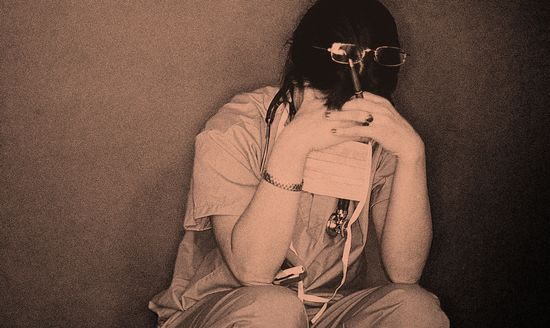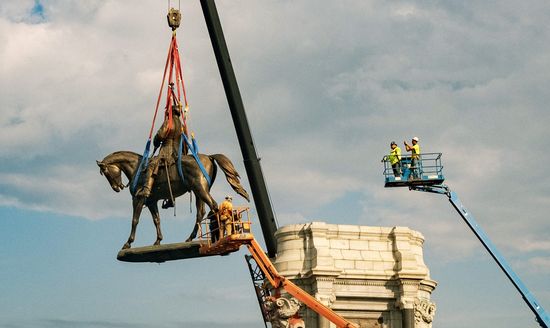| Benjamin Hart: After a long, brutal stretch, the Delta variant is finally on the wane in the U.S. Cases are dropping rather precipitously, but from an extremely high recent ceiling. Hospitalizations are down, and deaths are probably starting to level off and decline, but they are only now falling below 2,000 a day. We’re entering a period during which airborne diseases usually thrive in much of the U.S., but the country is significantly more vaccinated than it was a few months ago — 77 percent of adults over 18 have received one dose — in large part thanks to the destruction wrought by the variant. (Mandates have also helped.) How do you view the domestic pandemic situation right now? |
| David Wallace-Wells: I’m not sure I’d say “precipitously,” but yes, things are at least moving in the right direction. But before we talk about what’s next, let’s just dwell on “brutal.” What I find striking about the national data is just how terribly bad the situation has been, and continues to be, especially in terms of severe disease and death. For the past few weeks, the country has been hovering around a daily average of 150,000 new cases — somewhere between half and two-thirds of the winter-surge peak. Nobody was vaccinated then, and the seasonality effects could be said to have been at their most intense. But deaths and hospitalizations are hardly any lower, proportionally, than they were back then; we’re at about two-thirds of each peak right now. By contrast, in England — yes, admittedly, a different country, with a different population, and somewhat better vaccination rates — the Delta surge produced barely one-tenth the death rate of its winter peak. Plus, just looking at the raw numbers: 2,000 Americans have been dying every day for weeks now. It has been horrific. |
| For most of 2020, many Americans — particularly liberal Americans — viewed the country’s pandemic as a horrific outlier. Statistically, though we certainly should have and could have done better, the country was not really an exceptional case among its peer nations, at least judged in terms of per capita death rate. But in this wave the country has indeed been an outlier, with no similarly vaccinated country experiencing nearly the amount of death we have. I think the relief of being personally vaccinated has blinded many Americans to just how bad the toll has been: This month, September, is going to be the fourth-most deadly month of the entire pandemic, behind only April 2020 and January and February 2021. |
| Ben: Back in late June, as the Delta variant was really starting to pick up steam, in the U.S., you and I discussed the damage it might be capable of doing here. You said that “in two profound ways, the variant, while scary, isn’t quite the nightmare development it may sound like. The first is that vaccines — especially the two-dose mRNA vaccines — remain very effective against it, essentially as effective as they are against the earliest strains of the disease. And the second is that, while Delta does appear significantly more transmissible, it is much less clear that it is any more dangerous to those who do get infected.” And also that “the crudest metric of severity, case-fatality rate, appears notably lower than for earlier variants — at least in the U.K.” I am in no way trying to “dunk” on you here, because I don’t think almost anyone foresaw what was about to happen. I’m more curious about why things got so bad in the U.S., and so much worse than in other rich countries. I know there’s more vaccine hesitancy here than in other places, especially in certain pockets, but is that difference alone enough to account for this wide gulf? |
| David: I think in the big picture it remains quite a serious mystery, which no one has yet adequately explained, and perhaps another sign of the fact that — as reluctant as we are to admit it — many of the drivers of pandemic spread remain somewhat inscrutable to us. But almost as soon as the Delta surge began here, you could see the pattern emerging. On July 24, I talked to Eric Topol about exactly this: that, compared to the experience of Britain, which seemed like a natural guide to what we would see in the U.S., simply many more people were going into the hospital and dying here. |
| If I had to gather hypotheses now, looking back, I’d list a few possibilities, though I certainly wouldn’t feel comfortable endorsing any of them in full: the possibility that, indeed, the Delta variant is more severe in addition to being more transmissible; the nature of regionalization, where you have certain relatively large pockets of quite vulnerable people even in a county with relatively high vaccination rates, such that national vaxx figures and even state-level vaxx figures don’t really tell the story of vulnerability; the simple size of the country, which means that even if those pockets are relatively few there are still, in raw numbers, a lot of people in them; political indifference in many of the places worst hit by Delta. |
| One thing I’ve been thinking about more over the past few days is the additional possibility that some of the basic messaging about vaccine efficacy has been misleading on a related point. According to the CDC, across the population as a whole, vaccines reduce the risk of infection by seven times and of death by 11 times (roughly speaking — each effect varies by age and individual, of course). But those aren’t two distinct effects; the second number contains the first. Which suggests that, given an infection, the protection offered against severe disease and death may be somewhat smaller than we’ve been told — or, to put it another way, that a bigger part of the vaccine’s work is done preventing infection than those numbers (or the messaging around them) imply. In theory, at least, that might also help explain why, even given vaccines, the ratio of deaths to cases remains distressingly high. But in general, I don’t think we have a very clear understanding and wish both the public discourse and journalism on the current state of the pandemic were more focused on the phenomenon. As I said a minute ago, it has been a horrifically brutal late summer. |
| Ben: You wrote recently about the drastic age skew of this virus, which is still hard to internalize 18 months in. And perhaps for good reason — thousands upon thousands of prime-age adults have died of COVID, and one doesn’t want to minimize that. But looking to by far the most at-risk age group: Only 83 percent of Americans over 65 are fully vaccinated, with 93 percent having received at least one dose. Could that small but crucial group of older vaccine holdouts account for most of what we’ve seen this summer? |
| David: The short answer is: yes. The age skew of the disease is extremely dramatic, which means that the elderly and especially the very elderly are much, much, much more vulnerable than even middle-aged people with bundles of comorbidities. But while 83 percent and 93 percent are frustratingly low numbers, they still suggest that, overall, vaccines would have reduced the mortality risk of America’s elderly by four-fifths. On the other hand, an alternate read of the same data is 83 percent of American seniors still means 9 million of them aren’t fully vaxxed, and as my piece pointed out, the older you are, the less complete the protection that vaccination offers really is, which means that some of the vaccinated elderly are still dying, too. It’s also the case that seniors are often concentrated in certain areas: in Florida, for instance, which has been by far the worst-hit state during this surge, with higher death rates than any other state or than it has seen at any point in the pandemic despite apparently average vaccination rates by national standards. |
| (I say that last bit because there are some anecdotal indications that Florida’s vaccine rates may not be entirely reliable, possibly reflecting some amount of “vaccine tourism” in which people came in to get shots, then left the state or the country.) |
| All that said, this is a possible explanation for the raw size of the Delta death toll — that there are simply a lot of unprotected or partially protected people still. It isn’t, at least as I understand it, an explanation for the high ratio of deaths to cases in the age of widespread vaccination. In theory, at least, given our level of vaccine uptake, if you presume 2,000 deaths a day, as we’ve seen now for a few weeks, you’d expect to see much, much higher case rates than we’ve had. And while for a time you might have pointed to inadequate testing levels to suggest that, perhaps, we just weren’t testing enough to see the full scale of pandemic spread, we are now testing at roughly the rate we were during the winter surge, and the ratios are still distressingly high. |
| Ben: Okay, so I guess one lesson here is that making predictions about the pandemic’s shape to come is fiendishly difficult. And it feels like tempting fate to even ask whether the worst is truly over now. So I’ll frame things a different way: Is the biggest worry heading into the winter another surge among mostly unvaccinated people like the one we are still seeing, or is it that immunity may be waning from the initial shots among the older people who make up such a large percentage of deaths? (One would imagine that getting booster shots to north of 80 percent of that population may be a bigger challenge than the initial vaccine push.) And is either scenario likely to produce as bad an outcome as this summer’s? |
| David: Unless vaccination levels move rapidly up, I would guess that, going forward, most of the serious and severe cases will continue to be among the unvaccinated, with a smaller but nonzero number of serious breakthrough cases concentrated among the very old. Beyond that, I’d be reluctant to make predictions, to be honest — our experience is already so different from even those countries we consider natural comparisons that it’s hard to know on what basis to make them. In Germany, for instance, where vaccination rates roughly match ours, not only did Delta not produce a surge of deaths, it didn’t even produce a surge of cases — the variant just took over without really elevating the number of infections. I do think it’s quite likely that we’re past the peak of this surge. Will we get a fall or winter surge? Will those surpass this one? If I had to guess, I’d say there will be at least another surge, powered in part by seasonality, and that it might approach this peak without surpassing it. But until we have a better understanding of why this surge was so deadly, I think it’s a bit premature to really say. |
| |









